
A centimetre or centimeter is a unit of length in the metric system, equal to one hundredth of a metre, centi being the SI prefix for a factor of 1/100. The centimetre was the base unit of length in the now deprecated centimetre–gram–second (CGS) system of units.
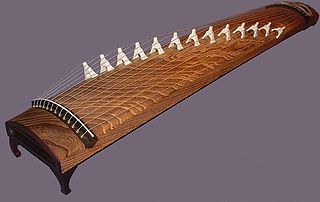
The koto is a Japanese stringed musical instrument derived from the Chinese zheng, and similar to the Mongolian yatga, the Korean gayageum, and the Vietnamese đàn tranh. The koto is the national instrument of Japan. Koto are about 180 centimetres (71 in) length, and made from kiri wood. They have 13 strings that are usually strung over 13 movable bridges along the width of the instrument. There is also a 17-string variant. Players can adjust the string pitches by moving the white bridges before playing. To play the instrument, the strings are plucked using three finger picks.

Measurement is the assignment of a number to a characteristic of an object or event, which can be compared with other objects or events. The scope and application of measurement are dependent on the context and discipline. In the natural sciences and engineering, measurements do not apply to nominal properties of objects or events, which is consistent with the guidelines of the International vocabulary of metrology published by the International Bureau of Weights and Measures. However, in other fields such as statistics as well as the social and behavioral sciences, measurements can have multiple levels, which would include nominal, ordinal, interval and ratio scales.
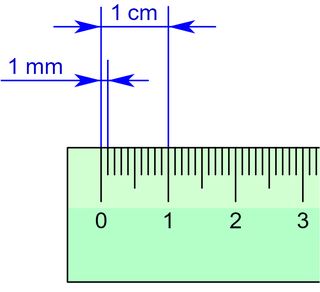
The millimetre or millimeter is a unit of length in the metric system, equal to one thousandth of a metre, which is the SI base unit of length. Therefore, there are one thousand millimetres in a metre. There are ten millimetres in a centimetre.

In gymnastics, the floor refers to a specially prepared exercise surface, which is considered an apparatus. It is used by both male and female gymnasts. The event in gymnastics performed on floor is called floor exercise. The English abbreviation for the event in gymnastics scoring is FX.

The shamisen or samisen (三味線), also sangen, is a three-stringed traditional Japanese musical instrument derived from the Chinese instrument sanxian. It is played with a plectrum called a bachi.
Gagaku is a type of Japanese classical music that has been performed at the Imperial Court in Kyoto for several centuries and today by the Board of Ceremonies at Tokyo Imperial Palace. This kind of music was first imported into Japan from China; however, artistically it differs from the music of the corresponding Chinese form yayue which is a term reserved for ceremonial music. Gagaku consists of three primary repertoires:
- Native Shinto religious music and imperial songs and dance, called kuniburi no utamai
- Vocal music based on native folk poetry, called Utaimono
- Songs and dance based on foreign music

A zafu or putuan is a round cushion. Although also a utilitarian accessory, it is best known for its use in zazen Zen meditation.

A triangulation station, also known as a triangulation pillar, trigonometrical station, trigonometrical point, trig station, trig beacon, or trig point, and sometimes informally as a trig, is a fixed surveying station, used in geodetic surveying and other surveying projects in its vicinity. The nomenclature varies regionally: they are generally known as trigonometrical or triangulation stations in North America, trig points in the United Kingdom, trig pillars in Ireland, trig stations or points in Australia and New Zealand, and trig beacons in South Africa; triangulation pillar is the more formal term for the concrete columns found in the UK.

The term double clarinet refers to any of several woodwind instruments consisting of two parallel pipes made of cane, bird bone, or metal, played simultaneously, with a single reed for each. Commonly, there are five or six tone holes in each pipe, or holes in only one pipe while the other acts as a drone, and the reeds are either cut from the body of the instrument or created by inserting smaller, slit tubes into the ends of the pipes. The player typically uses circular breathing.
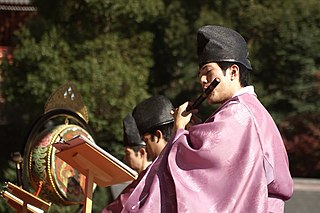
The ryūteki is a Japanese transverse fue made of bamboo. It is used in gagaku, the Shinto classical music associated with Japan's imperial court. The sound of the ryūteki is said to represent the dragons which ascend the skies between the heavenly lights and the people of the earth. The ryūteki is one of the three flutes used in gagaku, in particular to play songs of Chinese style. The pitch is lower than that of the komabue and higher than that of the kagurabue.
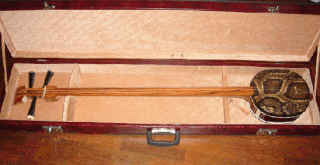
The sanxian is a Chinese lute—a three-stringed fretless plucked musical instrument. It has a long fingerboard, and the body is traditionally made from snake skin stretched over a rounded rectangular resonator. It is made in several sizes for different purposes and in the late 20th century a four-stringed version was also developed. The northern sanxian is generally larger, at about 122 cm (48 in) in length, while southern versions of the instrument are usually about 95 cm (37 in) in length.
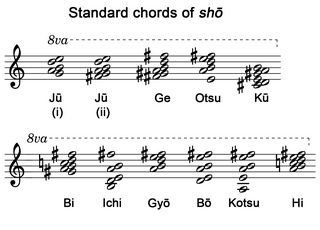
The shō (笙) is a Japanese free reed musical instrument that was introduced from China during the Nara period. It is descended from the Chinese sheng, although the shō tends to be smaller in size. It consists of 17 slender bamboo pipes, each of which is fitted in its base with a metal free reed. Two of the pipes are silent, although research suggests that they were used in some music during the Heian period.

Shimadzu Corporation is a Japanese public KK company, manufacturing precision instruments, measuring instruments and medical equipment, based in Kyoto, Japan. It was established in 1875. The American arm of the company, Shimadzu Scientific Instruments, was founded in 1975.

Obi(帯, おび) is a sash for traditional Japanese dress, keikogi, and part of kimono outfits.

In Japanese architecture, fusuma are vertical rectangular panels which can slide from side to side to redefine spaces within a room, or act as doors. They typically measure about 90 centimetres (3.0 ft) wide by 180 centimetres (5.9 ft) tall, the same size as a tatami mat, and are two or three centimeters thick. The heights of fusuma have increased in recent years due to an increase in average height of the Japanese population, and a 190 centimetres (6.2 ft) height is now common. In older constructions, they are as small as 170 cm high. They consist of a lattice-like wooden understructure covered in cardboard and a layer of paper or cloth on both sides. They typically have a black lacquer border and a round finger catch.

Leblanc, Inc. was a musical instrument manufacturer based in Kenosha, Wisconsin. The company was a woodwind manufacturer known mainly for its clarinets. In 2004 the firm was sold to Conn-Selmer, a division of Steinway Musical Instruments. Leblanc has ceased to exist as an independent operation and has become a brand of Conn-Selmer.
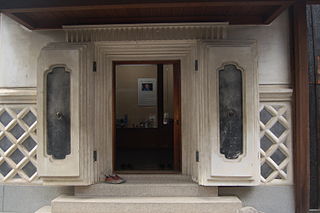
Namako wall or Namako-kabe is a Japanese wall design widely used for vernacular houses, particularly on fireproof storehouses by the latter half of the Edo period. The namako wall is distinguished by a white grid pattern on black slate. Geographically, it was most prominent in parts of western Japan, notably the San'in region and San'yō region and, from the 19th century, further east, in the Izu Peninsula.
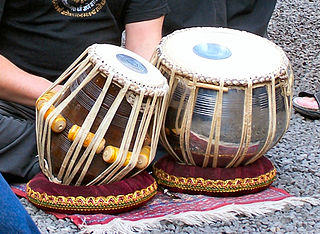
The tabla is a membranophone percussion instrument originating from the Indian subcontinent, consisting of a pair of drums, used in traditional, classical, popular and folk music. It has been a particularly important instrument in Hindustani classical music since the 18th century, and remains in use in India, Pakistan, Afghanistan, Nepal, Bangladesh, and Sri Lanka. The name tabla likely comes from tabl, the Persian and Arabic word for drum. However, the ultimate origin of the musical instrument is contested by scholars, some tracing it to West Asia, others tracing it to the evolution of indigenous musical instruments of the Indian subcontinent.
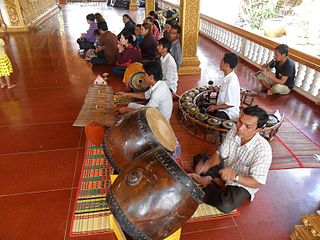
The Skor thom (ស្គរធំ) are Cambodian 2-headed barrel drums played with a pair of wooden drumsticks. They typically have skin heads made from oxen, cows or buffalos, and are played in pairs. The drums are tuned such that one will give a "tighter and louder" sound when struck, while the other gives a "loose and more flatter tone." The log is hollowed out to form a thin tube, about 1 centimeter thick, and the hide is stretched out on each side to create the drum. Dimensions for the instruments vary, as they are carved from logs; however they can measure 50 centimetres long and be 46 centimetres in across at the center of the drum, with the ends beinng about 40 centimetres wide.





















